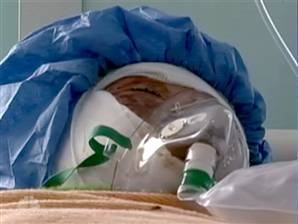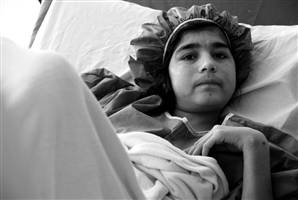NBC News, October 29, 2009
Afghan girls burn themselves to escape marriage
Afghan girls burn themselves to escape marriage Many girls in Afghanistan think self-immolation is the best solution for family problems, according to Jalali.
By Adrienne Mong, NBC News Correspondent
HERAT, Afghanistan – We watched a teenage girl die last Friday.

Shirin was married two years ago when she was 15 years old. ... Six hours after we first met Shirin, she died. (NBC News)
Seventeen-year-old Shirin had been brought to the Herat Regional Hospital Burns Unit a few days before we met her. Ninety percent of her body was covered in third-degree burns.
Her mother-in-law said Shirin had burned herself by accident. The girl was preparing a meal in the kitchen but somehow confused cooking gasoline with petrol, she said.
But Dr. Mohamed Aref Jalali, the director of the burns unit, said Shirin told him in private that she had set herself on fire deliberately after fighting with her mother-in-law and her sister-in-law.
Many girls in Afghanistan think self-immolation is the best solution for family problems, according to Jalali.
"[For these girls], it’s no good to solve the problem with the father-in-law, with the mother-in-law," said the doctor. "They think self-immolation will solve the problem."
It’s a "solution" that appears to be a major problem in Afghanistan, particularly among young women between the ages 13 and 25.
In the first seven months of this year, medical staff at the Herat’s burns unit – the only one of its kind in the entire country – said they have seen 51 cases of female self-immolation. Only 13 have survived.
The practice comes from Iran, where many Afghan refugees had fled to during the decade-long war with the Soviet Union (1979-1989) and the era of mujahedeen fighting that followed in the 1990s, said Jalali. But its popularity has spread among Afghan women, often from poor, uneducated backgrounds, where the tradition of child or forced marriages runs strong.
"The forced marriage is the best reason and the important reason, and it starts from the economic problem," said Jalali.
Often in arranged marriages, women are viewed in very stark terms.
"She is here only to wash, to clean, to give baby … and nothing more," said Marie-Jose Brunel, a French volunteer nurse at the burns unit who was full of Gallic warmth and purposeful seriousness. "If they have no freedom, no possibility to study, to be considered like nothing, it’s very, very difficult."
Domestic violence
Shirin was married two years ago when she was 15 years old.
But another patient we found at the hospital, down the hall from Shirin, was Rezagul. Skinny and illiterate, the 13-year-old was married at 11 to a man who was almost 20 years older. He was abusive, she told us, beating her whenever she failed to do her housework. So did her in-laws. "My cruel sister-in-law, brother-in-law, and husband … they beat me," she said.
Out of frustration and homesickness for her own family, Rezagul took drastic action.
"I was in very bad condition," she recalled. "I poured gasoline on myself and set myself on fire. I didn’t want to be alive." The burns covered the lower half of her body.
It took several months for her skin to heal properly and she was currently back at the clinic because of chronic kidney pain. Jalali said he would need to finish reconstructive surgery on Rezagul but with physical therapy she would recover nicely.
On the day we visited, Rezagul looked well-adjusted and almost happy. She was no longer married. Her father had welcomed her back home. She was excited about starting to go to school for the first time in her life.
In fact, with her burns covered up, Rezagul looked the picture of health as Brunel, the nurse, teased her – a testament to the success of the burns unit.
Filling a critical void
Brunel, who is usually based in the south of France and volunteers her time at the clinic through the French non-governmental organization HumaniTerra International, has been working with the burn unit’s senior medical team since 2003.
In fact, she was instrumental in starting up the unit – originally as part of the main hospital with only a handful of beds and no trained staff – after a meeting with then-governor of Herat, Ismael Khan, who emphasized the need for a place to treat burns.
In October 2007, after years of fundraising, planning, and training, Brunel and her Afghan colleagues opened the treatment center we were visiting.
On average, it receives 600 to 700 burn patients a year, the majority of whom are victims of domestic accidents, mostly children. In fact, one ward had dozens of infants – most of them with various limbs wrapped up in gauze and bandages, usually from boiling water that had spilled over from a kettle.
Still, a significant portion of the patients are victims of self-immolation – at least 10 percent, according to statistics kept by the burn unit. "In 2003, when we started, we estimate 350 [self-immolation] cases a year for Herat," recalled Brunel. The number has decreased – at least for those victims from Herat Province – after the hospital and the local government launched a public awareness campaign.
"We have seen decreases," said Brunel. "And I hope with the second year of [the public awareness] campaign, it’s better again."
But they need funding, and time. While the incidents of self-immolation from within the province may be on the decline, cases from outside Herat are on the rise.
"It’s going to the other provinces," said Jalali. "Now we have patients from Farah Province, from Nimruz, from Badgis, from Helmand."
A lost life

Rezagul set herself on fire to escape her marriage to an abusive and much older husband. (Adrienne Mong/ NBC News)
During our visit, we checked back on Shirin every now and then. She had long ago slipped into a delirious state and was murmuring nonstop. Her mother, Hanifa Ahmadi, hovered around her, occasionally stroking her hair.
Ahmadi – a thin, handsome woman who looks more Persian than Afghan – said she didn’t understand why her daughter had set herself on fire. "Shirin is always a happy girl and gets along with everyone," she said.
Ahmadi was convinced that Shirin would soon recover and leave the hospital, but Jalali was unequivocal.
"She doesn’t have long. Maybe she has one hour, an hour-and-a-half," he said. "It’s unfortunate, but we can’t do anything. Not with 90 percent burns all over the body, third-degree burns."
Brunel agreed. "We can do nothing except … we give dignity," she said. She and an Afghan orderly had taken turns trying to make Shirin as comfortable as possible – giving her a tube to make her breathing easier, feeding her, or just straightening the blankets that covered her burnt body.
The end came later than Jalali had predicted, but come it did. Six hours after we first met Shirin, she died.
Members of her family rushed past us in the hallway, her mother, then her uncle, an aunt, and then her husband – he looked more confused than grief-stricken. They piled into Shirin’s room, wailing, walking back and forth around her bed, hands wringing; even the mother-in-law, with whom the young girl had been fighting just days before.
We stepped away quietly, gathering our things, preparing to leave and trying not to intrude.
But as we walked down the hallway one last time, I ducked my head into the room where Rezagul lay. She looked up, her eyes aglow, and she waved.
The picture of health.
Characters Count: 9053
